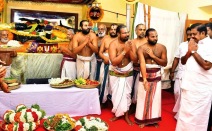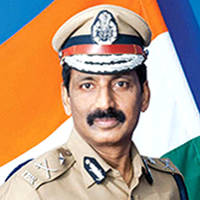REFLECT REJOICE AND RING IN THE NEW YEAR

As the New Year hovers just around the corner, it’s time to reflect, take stock of the year past, and plan for the year ahead. Looking back on the year need not be about beating oneself up and evaluating what we could have done well but also about rejoicing because it’s too easy to dwell on setbacks and bypass the wins and the good that comes within any year. When we work hard, quickly, and continually in challenging contexts, our brains obliterate the positive as we focus on the burdens and pressures at hand. But recalling the good fuels our wellbeing and nourishes us with inner reserves to soar to the new. challenges. Taking stock of what went well this year and understanding that no win is too small to own and celebrating small triumphs can provide positive fuel for the days and years.
 Looking back on this year, the most challenging time we had was in the month of July and August of 2019. We know that Mahamaham at Kumbakonam is held once in 12 years and Kumbh Mela is held once every 4 years but at any one place Kumbh Mela is held once in 12 years. But a temple festival that is held once in 40 years is something very absurd and unthinkable to keep track, remember, assess and make plans. As the Athi- Varadar festival comes about once in 40 years, a person gets to witness the festivities only once or to a maximum twice in his lifetime. It’s thus an enormous challenge to assess how many devotees would turn out if the temple were to reopen after a lapse of 40 years. When the Athi-Varadar festival commenced on July 1, 2019. I was less than one month old as ADGP L&O. During the coordination meeting, the authorities connected with the temple came up with an estimate that there could be a daily footfall of 15000 to 20000 devotees per day. Despite, the assessment pointed out during the meeting and in spite of having no clue of what to expect, as a measure of abundant caution we chose to formulate and implement a bandobast plan which envisaged one lakh footfalls per day. Retrospectively, what we had unknowingly worked out was an estimate which was way beyond the footfalls witnessed at Tirupati temple which receives the highest footfall in the country or for that matter any of the temples in our country which are known for impressive footfalls. For instance, Sri Venkateswara Swamy temple that is popularly known as Tirupati temple and the most famous temple of our country receives the highest footfalls which are anywhere between 50000 to 60000 footfalls on an average day. The other four temples which receive high footfalls in our country are Padmanabhaswamy Temple in the city of Thiruvananthapuram in Kerala at 50000 to 55000 footfalls, Vaishnodevi Temple at Jammu, at 30000 to 40,000 footfalls, Golden Temple at Amritsar at 40000 footfalls and Jagannath temple at Puri at around 30000 footfalls per day. Despite making an assessment which was way beyond the biggest and the most popular temples in our country, the devotees thronging Athi-Varadar temple defied all anticipations and threw the crowd management system and the city of Kanchipuram out of gear by
Looking back on this year, the most challenging time we had was in the month of July and August of 2019. We know that Mahamaham at Kumbakonam is held once in 12 years and Kumbh Mela is held once every 4 years but at any one place Kumbh Mela is held once in 12 years. But a temple festival that is held once in 40 years is something very absurd and unthinkable to keep track, remember, assess and make plans. As the Athi- Varadar festival comes about once in 40 years, a person gets to witness the festivities only once or to a maximum twice in his lifetime. It’s thus an enormous challenge to assess how many devotees would turn out if the temple were to reopen after a lapse of 40 years. When the Athi-Varadar festival commenced on July 1, 2019. I was less than one month old as ADGP L&O. During the coordination meeting, the authorities connected with the temple came up with an estimate that there could be a daily footfall of 15000 to 20000 devotees per day. Despite, the assessment pointed out during the meeting and in spite of having no clue of what to expect, as a measure of abundant caution we chose to formulate and implement a bandobast plan which envisaged one lakh footfalls per day. Retrospectively, what we had unknowingly worked out was an estimate which was way beyond the footfalls witnessed at Tirupati temple which receives the highest footfall in the country or for that matter any of the temples in our country which are known for impressive footfalls. For instance, Sri Venkateswara Swamy temple that is popularly known as Tirupati temple and the most famous temple of our country receives the highest footfalls which are anywhere between 50000 to 60000 footfalls on an average day. The other four temples which receive high footfalls in our country are Padmanabhaswamy Temple in the city of Thiruvananthapuram in Kerala at 50000 to 55000 footfalls, Vaishnodevi Temple at Jammu, at 30000 to 40,000 footfalls, Golden Temple at Amritsar at 40000 footfalls and Jagannath temple at Puri at around 30000 footfalls per day. Despite making an assessment which was way beyond the biggest and the most popular temples in our country, the devotees thronging Athi-Varadar temple defied all anticipations and threw the crowd management system and the city of Kanchipuram out of gear by  luring ten to fifteen times more crowd than what the authorities had evaluated initially. Crowd management during the Athi-Varadar festival became a huge challenge to the police as unprecedented crowds of over two lakh devotees started thronging the temple. Challenge was further compounded by the configuration of the temple which only had a single entrance and a single exit, absence of structures to marshal pilgrims, dependency on one major exit, permitting excess pilgrims over its holding capacity, limited holding area at the entrance and the exit, dearth of emergency exits, and narrow streets around the temples. All of which were recipes for crowd disasters such as stampedes. Amid massive human deluge, we also had to stave off other threats to safeguard pilgrims from it. Following the revocation of Art 370, there were apprehensions of a jihadi or a fedayeen type of attack from fundamentalists. To combat the threats, we had to work hard covertly to secure the lives of the devotees. Finally, Athi-Varadar festival of 2019 ended up witnessing a turnout of over 14 million pilgrims showing up to pay obeisance to Lord Athi-Varadar during the 48 days of its festivities. The festival drew to a close with the deity being laid to rest in the Ananthasaras tank at the Varadaraja Perumal temple on 18, August 2019. The challenge of managing 2-3 lakh devotees, for 48 days at a stretch without any major incidents was by far the greatest challenge we have ever faced and our Honourable Chief Minister was extremely gracious in the end to recognise all the police personnel who performed bandobast duties with an Athi-Varadar Special Service medal.
luring ten to fifteen times more crowd than what the authorities had evaluated initially. Crowd management during the Athi-Varadar festival became a huge challenge to the police as unprecedented crowds of over two lakh devotees started thronging the temple. Challenge was further compounded by the configuration of the temple which only had a single entrance and a single exit, absence of structures to marshal pilgrims, dependency on one major exit, permitting excess pilgrims over its holding capacity, limited holding area at the entrance and the exit, dearth of emergency exits, and narrow streets around the temples. All of which were recipes for crowd disasters such as stampedes. Amid massive human deluge, we also had to stave off other threats to safeguard pilgrims from it. Following the revocation of Art 370, there were apprehensions of a jihadi or a fedayeen type of attack from fundamentalists. To combat the threats, we had to work hard covertly to secure the lives of the devotees. Finally, Athi-Varadar festival of 2019 ended up witnessing a turnout of over 14 million pilgrims showing up to pay obeisance to Lord Athi-Varadar during the 48 days of its festivities. The festival drew to a close with the deity being laid to rest in the Ananthasaras tank at the Varadaraja Perumal temple on 18, August 2019. The challenge of managing 2-3 lakh devotees, for 48 days at a stretch without any major incidents was by far the greatest challenge we have ever faced and our Honourable Chief Minister was extremely gracious in the end to recognise all the police personnel who performed bandobast duties with an Athi-Varadar Special Service medal.
 The second major challenge that came our way was on October 2, when Trichy city woke up to a major break-in. It was its second major burglary in just a year. Two men dramatically wearing masks of cat and dog had broken into Lalitha Jewellery Showroom after drilling a hole into the wall of the showroom and decamped with jewellery worth approximately ₹13 crores. The CCTV footage disclosed two men in animal masks entering the show-room and tossing the jewels into a bag. Just nine months ago in January, masked men broke into Punjab National Bank (PNB) at Bikshandarkoil in Trichy and made away with Rs 19 lakh and 450 sovereigns of gold. The same gang apparently had also made unsuccessful attempts at robbing the Indian Overseas Bank branch at Uppiliapuram, a Kerala-based private finance company at Samayapuram, and a co-operative bank at Manachanallur.
The second major challenge that came our way was on October 2, when Trichy city woke up to a major break-in. It was its second major burglary in just a year. Two men dramatically wearing masks of cat and dog had broken into Lalitha Jewellery Showroom after drilling a hole into the wall of the showroom and decamped with jewellery worth approximately ₹13 crores. The CCTV footage disclosed two men in animal masks entering the show-room and tossing the jewels into a bag. Just nine months ago in January, masked men broke into Punjab National Bank (PNB) at Bikshandarkoil in Trichy and made away with Rs 19 lakh and 450 sovereigns of gold. The same gang apparently had also made unsuccessful attempts at robbing the Indian Overseas Bank branch at Uppiliapuram, a Kerala-based private finance company at Samayapuram, and a co-operative bank at Manachanallur.
Within 24 hours of the heist, on October 3 a team of policemen who were conducting vehicle check in Thiruvarur under the leadership of a sub-inspector caught Manikandan, a resident of the same town. Manikandan, who moving around on a two-wheeler with his friend Seerathoppu Suresh, was carrying 4.25 kg of gold in a cloth bag. “Police retrieved the gold and arrested Manikandan, but Suresh who was accompanying him fled from the vehicle at the checking point,”
 We later searched Suresh’s house and found 450 gram jewellery and his mother Kanagavalli. As soon as we arrested Kanagavalli on Oct 4, her son Suresh surrendered before a lower court in Chengam, Thiruvannamalai. As Suresh is a close relative to history-sheeter Murugan, we realized then that we had more or less cracked the case and we were convinced that Murugan was the kingpin in the heist. Soon after we could lay our hands on Ganeshan, who during his interrogation admitted not only to the heist at Lalitha Jewellery and also confessed to his involvement in the Punjab National Bank burglary. Investigation was also able to establish the involvement of Suresh, Murugan and Ganesan in the PNB theft and several other cases, too. On 11 October 2019, main accused Murugan surrendered before a court in Bangalore, and on his confession recovery of 11946.390. grams of gold, diamond and platinum jewels, concerned in Tiruchirappalli Lalitha Jewellery theft case was made from him on 12.10.2019. This case was easily the catch of the year as it was one of the biggest detections in the entire country where police could recover 25955.830. grams of ornaments with the arrest of five criminals for their involvement in the case.
We later searched Suresh’s house and found 450 gram jewellery and his mother Kanagavalli. As soon as we arrested Kanagavalli on Oct 4, her son Suresh surrendered before a lower court in Chengam, Thiruvannamalai. As Suresh is a close relative to history-sheeter Murugan, we realized then that we had more or less cracked the case and we were convinced that Murugan was the kingpin in the heist. Soon after we could lay our hands on Ganeshan, who during his interrogation admitted not only to the heist at Lalitha Jewellery and also confessed to his involvement in the Punjab National Bank burglary. Investigation was also able to establish the involvement of Suresh, Murugan and Ganesan in the PNB theft and several other cases, too. On 11 October 2019, main accused Murugan surrendered before a court in Bangalore, and on his confession recovery of 11946.390. grams of gold, diamond and platinum jewels, concerned in Tiruchirappalli Lalitha Jewellery theft case was made from him on 12.10.2019. This case was easily the catch of the year as it was one of the biggest detections in the entire country where police could recover 25955.830. grams of ornaments with the arrest of five criminals for their involvement in the case.
The third massive the challenge which got thrown at us during the year was the hosting of the second informal India-China Summit in which two of the gigantic leaders of the world namely the President Xi Jinping of the People’s Republic of China and Prime Minister of India Narendra Modi met on October 11 and 12 met at Mahabalipuram. Authorities probably chose Mahabalipuram as a venue for historical reasons. Literature reveals that after the decline of the Gupta Dynasty, the Pallavas rose to power in South India, ruling from the third century until the end of the 9th century AD. Narasimhavarman I of the Pallava reign, who ruled the territory from AD 630 to almost AD 670, was known for his love of art and sculpture and he erected most of the monolithic rock-cut structures we notice in this region such as the famous Shore Temple and other monuments. Some foreign travellers referred to it as” The Seven Pagodas” while we now see five of them as the Pancharathas (Five Rathas or Chariots). Apart from arts and architecture, Narasimhavarman-I, one of the few kings who nobody would conquer in any of the wars, was also good with trading and having alliances with other countries, especially with China. Literature reveals that the Pallava Kings had a trade and defence connection with China, in which the kings consented to support China in keeping a check on the expansion of Tibet as a powerful nation, during those years. Bodhidharma, one of the well-known Buddhist Monk in China who is presumably the third son of a Pallava king, who trekked from Kanchipuram through Mamallapuram to China in 527 AD. Various studies by archaeologists and historians show Mamallapuram had commercial connections with countries like China, Sri Lanka, and other South-East Asian countries.
During the informal summit, we had to resort to a multilayer deployment of police personnel to ensure foolproof security. We had put in place a security blanket of several senior police officers and police personnel drawn from all over the state with massive use of technology such as drones and installation of over 500 CCTV cameras. When the summit ended, Prime Minister Narendra Modi lauded the Tamil Nadu Government and Honourable Chief Minister Palaniswamy for the “excellent arrangements” and China’s Ambassador to India, Sun Weidong, wrote to Honourable Chief Minister of Tamilnadu thanking him for the arrangements during President Xi Jinping’s India visit.
Not just this, we also had to deal with the regular annual challenges such as the Thiyagi Immanuvel Sekaran Memorial Day at Paramakudi, and the Pasumpon Muthuramalinga Thevar Guru Puja at Pasumpon which were totally incident-free. Besides such regular annual law and order engagements, we were this year also faced with several new challenges such as the revocation of the Art 370, in August 2019, the Supreme Court verdict over the Babri Masjid-Ram Janma Bhoomi issue, Citizen Amendment Act etc all of which required precise planning and adoption of stringent precautionary measures.
We have just two more days to go in 2019. Thinking back on the 363 days of this year, I think 2019 has been an amazing year for the police personnel of Tamilnadu because of the excellent support and guidance of the Government and its Home Department, which is responsible for the administration of Police. And also because of the wonderful and inspiring captaincy of our Director General of Police and the extraordinary police personnel of all ranks who have always endeavoured to rise higher than the expectations of the public and the government. It feels proud for me to belong to such an incredible force. It’s no miracle that “The India Today Group”, which ranks India’s states on a range of parameters for the ‘best performing’ and ‘most improved’ states across the country, in its 18th edition of the State of the States survey this year, chose Tamil Nadu as the best performing and most improved big state in law and order.
Source from: epaper/deccanchronicle/chennai/dt:30.12.2019
 Dr.K. Jayanth Murali is an IPS Officer belonging to 1991 batch. He is borne on Tamil Nadu cadre. He lives with his family in Chennai, India. He is currently serving the Government of Tamil Nadu as Additional Director General of Police, Law and Order.
Dr.K. Jayanth Murali is an IPS Officer belonging to 1991 batch. He is borne on Tamil Nadu cadre. He lives with his family in Chennai, India. He is currently serving the Government of Tamil Nadu as Additional Director General of Police, Law and Order.


